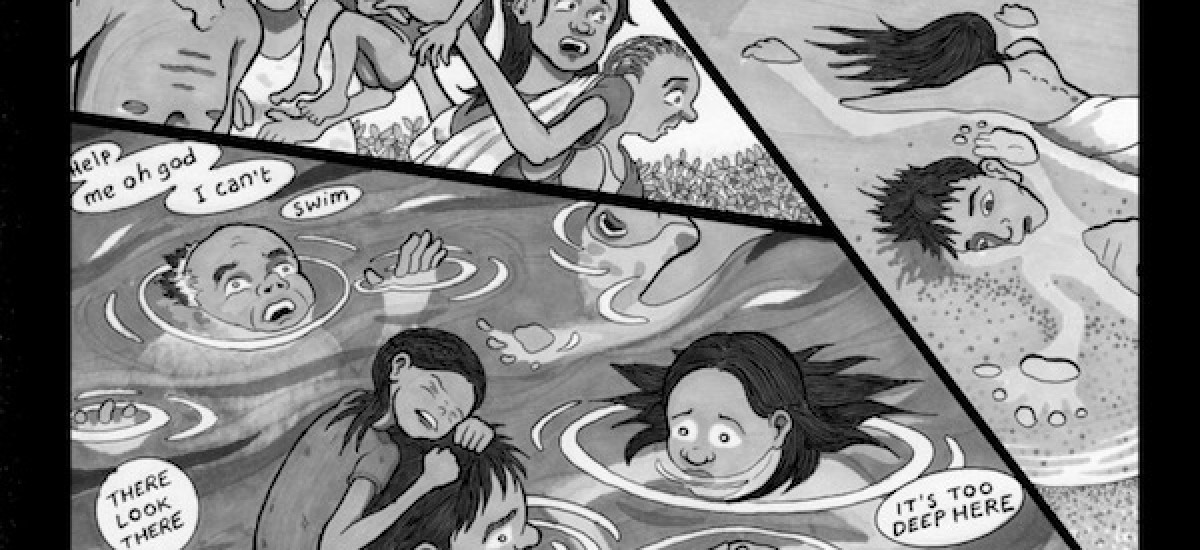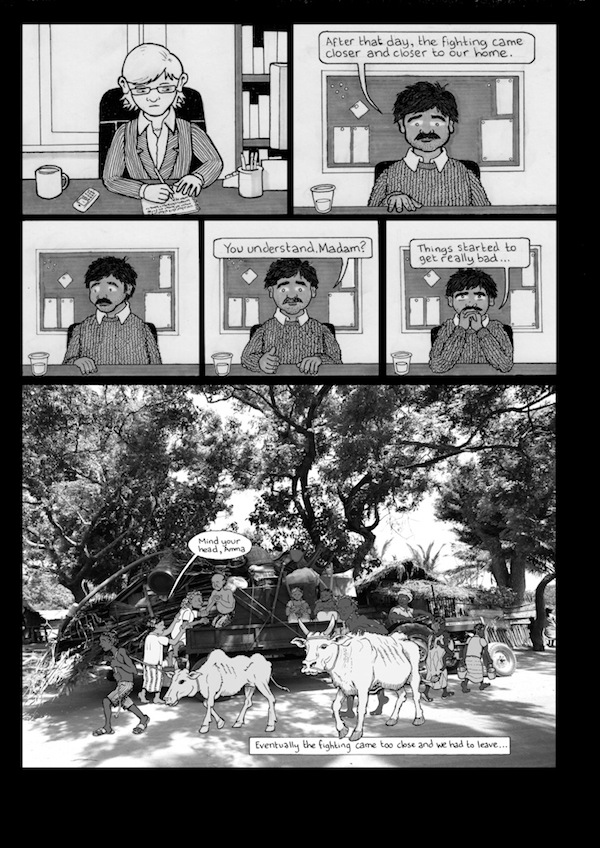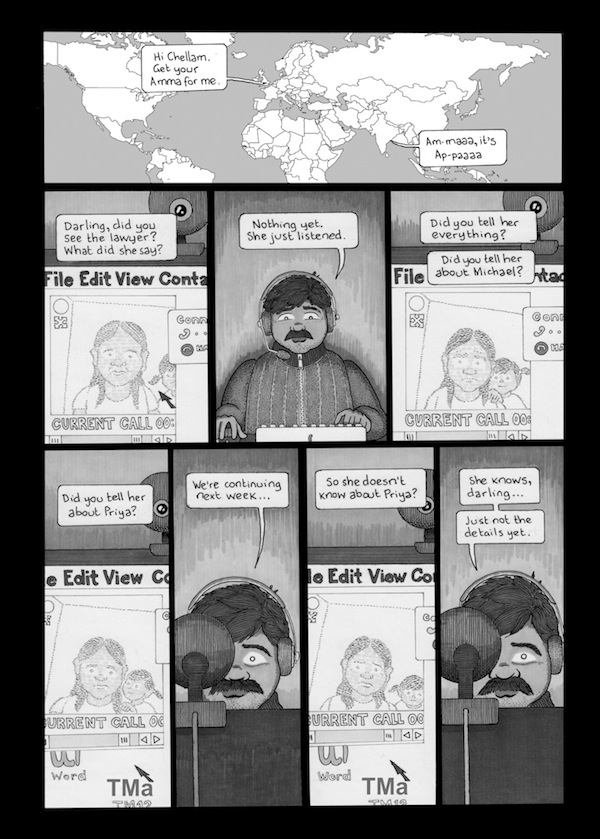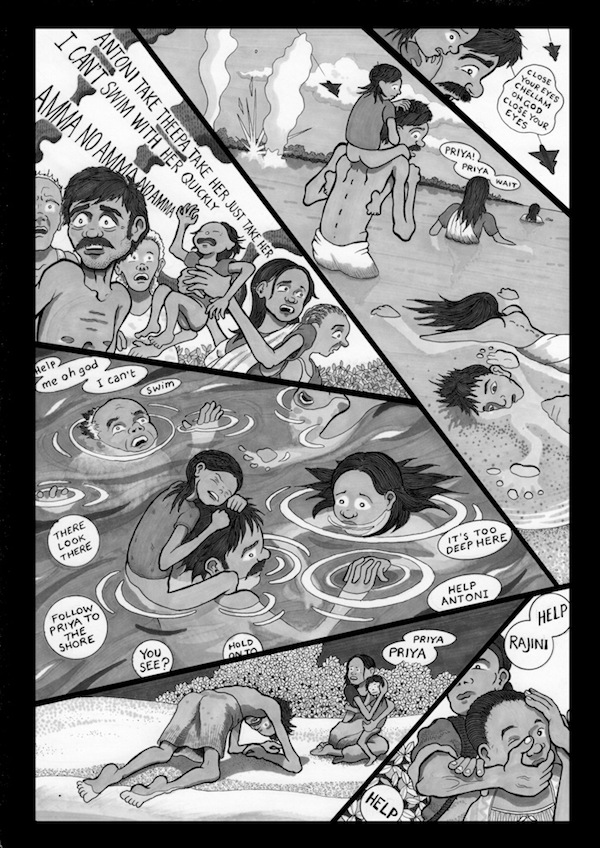Groundviews interviewed via email Benjamin Dix, who along with Lindsay Pollock are producing The Vanni, a multimedia graphic novel based on the hellish denouement of Sri Lanka’s 27 year old war in the first half of 2009. A preview can be viewed here. Since the live web version requires a modern browser with very good broadband, we’ve embedded just part of the preview as a video below.
Benjamin Dix and Lindsay Pollock have launched a campaign on KickStarter to support the production of The Vanni. You can read about and choose to support the campaign here. The following video is taken off the project’s KickStarter page.
Why you are producing The Vanni?
After working in Vanni for nearly four years, I had made many close friends within the communities in Kilinochchi, PTK and Mullaitivu. Working and living there was a real privilege; it was politically fascinating, environmentally stunning and culturally rich. The main thing that struck me was the decency and friendliness of the people; I was looked after, cared for and made genuine friends within the community. As the security situation spiralled throughout 2007 and 2008, it was heart breaking to see the villagers from the Mannar district displacing towards Kilinochchi. They arrived bedraggled, confused and shell shocked after displacing multiple times from the approaching army and its relentless shelling.
In September 2008, the UN evacuated and I lived through, by far the worst emotional experience of my life, having to say goodbye to people under such conditions. I did not agree with the decision to evacuate at that time and believed it was a premature move that could have been handled very differently. With the pleas for us to stay from the protesting communities at our compounds, we drove out of Vanni. The aftermath has now been well documented in Callum Macrea’s documentary Sri Lanka’s Killing Fields and most recently, in Frances Harrison’s book Still Counting the Dead.
That episode left a profound sadness inside me that has never lifted, mixed with a great sense of guilt and abandonment of friends and staff members; I wanted to try and give something back. The media coverage of the conflict has been incredibly limited, and I wanted to find a way to tell non-Sri Lanka specialists about the situation and tell the story of people that were forced to live through the war.
From 2009 until the present day, I continuously received messages from old friends and colleagues that find themselves in all corners of the world. I often received the messages through friend requests on Facebook! After talking with them about their experiences through the war on the beach, living through the horrors at Manik Farms and then leaving Sri Lanka, often for Chennai and then Europe, I decided I wanted to tell their story.
I had initially decided to tell the story from around 2006 to the end of 2009. But whilst visiting Tamil refugees in Chennai I realised that the aftermath of the conflict and the rippling effects were almost more compelling than the conflict itself.
I was in Chennai with a friend and her daughter and we celebrated, with an elaborate lunch, the arrest and detention of her husband, also an old friend of mine, in Zurich. He had spent nearly $20,000 with agents travelling from Chennai to Saudi, Istanbul, Kiev and to Zurich. The story was incredible and I relised how conflict continues in peoples lives long after the bombs stop falling. So I began to look at telling the story from this perspective – from the asylum seeker in the UK reflecting back on his life from 2006 to the present day in London.
What made you think of a graphic novel to look at the end of war in Sri Lanka?
I have been a fan of political graphic novels for a while now. Novels such as; Palestine by Joe Sacco, Persepolis by Marjane Satrapi and Maus by Art Spiegelman inspired me in the past to understand certain conflicts that I did not know too much about. I enjoy the media of the comic book, seeing the faces, expressions and the geography of where the story is set. Presenting it as an art form takes the reader into a different interaction with the narrative, using both visual and textual media.
Last year I watched the animated film Waltz with Bashir about the Israeli/Lebanese conflict. It is a stunning piece of animated art but what struck me was that toward the end of the film, the animation turns to film footage. I found that very striking as the viewer suddenly realised that this was a real story – not a cartoon. I then started to look at all the photographs and film clips I’d taken in Vanni over the 4 years I’d been there.
Working with Lindsay (the illustrator) we began to go through all of my images and collect others from the Internet and build a visual narrative that showed Vanni in its illustrated form, backed up with photography of the places and people.
I wanted to make something that was accessible to a wide audience, not just people interested in Sri Lanka and wanted to make it an educational experience. So we decided to start presenting it online and could therefore experiment with multi media techniques of embedding the illustrations with photographs, film clips and reference material.
By writing the book as a narrative about one family, I hope will make it accessible to everyone. I don’t want to tackle the huge numbers of dead and all the stories and politics that are connected to that, Frances Harrison has already done that exceptionally well in her book ‘Still Counting the Dead’. The international media is now awash with ‘so many thousand died here and there’ in various conflicts that I feel we might be slightly desensitised to these numbers. But by presenting the book as a narrative about one single family, I hope we can all empathise with them. We all come from a family and might be able to reflect on the emotions that they go through in the story of what it would be like to lose a loved one or simply not be able to protect your children in various circumstances. These are raw, human emotions.
Also, by writing it about a family personalises the whole narrative. We get to know the characters in the book. I hope it will help tackle some of the issues surrounding the notions of terrorism. One of the characters has to go and fight with the Tigers. But by knowing that character before that period, we can understand that they are not a demonic personality, in fact, they are incredibly gentle and loving, but intense circumstances, outside their control has led them to a situation where they have to fight and are now viewed by the world as a ‘terrorist’. That is a larger issue than just Sri Lanka. I believe that the vast majority of people in this world would like, if given the choice, to live in peace with their families but circumstances often force them to fight and are then perceived by the world as a terrorist.
The reference material is very important to the project as I don’t want it to be a book solely about Sri Lanka. We can therefore use Sri Lanka as the case study and build the narrative from the Sri Lankan experience, but can embed websites, academic articles and media articles behind the illustrations that deal with topics of, among others; conflict, migration, conscription and asylum. I hope by doing this it will create a new space where students and general readers can interact with these topics through new and innovative ways.
What made you sink your own money into the production of this web based graphic novel (a problem you could have as a foreigner easily moved away from)?
Most creative projects need to have an initial investment to get them off the ground. As previously mentioned, the evacuation from Vanni and the resulting situation left a profound sadness in me and writing this book is somewhat a cathartic exercise. The situation was relatively ignored by the international media and I wanted to tell the story to the world. Lindsay and I have self funded the book for a year now and have got to the point of presenting the preview on the Internet but for us to proceed into the far larger project we need financial backing.
I don’t think it matters that I was a foreigner in Vanni. Living there for four years, one makes deep relationships with people. I had a home there, my favourite place to watch sunsets, eat Kottu rotti, and motorbike at the weekends – in many respects it was ‘home’. When that home is destroyed and people you care about die, the colour of my skin or the country name on my passport makes no difference to the sense of loss.
What you hope to achieve by the publication of The Vanni?
I would like to achieve a couple of things with this book.
Firstly is to tell the story of civilians that had to live through this conflict. I am taking an ethnographic approach to the project. I am trying very hard to make it as impartial as possible and using the testimonies from survivors about their experiences. The project is not about political rhetoric, its voices of civilians who passed through the conflict and now find themselves as refugees scattered across the globe.
Secondly, I want to create a research tool that can be used by students and a general reader that focuses on issues such as conflict, migration, conscription, asylum and terrorism. To present these complex issues in an accessible illustrated narrative with literature embedded behind the illustrations is a unique way of presenting academic research. By using the medium of the graphic novel, I hope it will be accessible to a very wide readership.
Thirdly, I want to challenge people’s understanding of asylum seekers and conflict in the west. The media often portrays asylum seekers as people who scrounge off the system, that come and take our jobs etc. By presenting Antoni, the protagonist, in London and understanding what he went through to get here, and that being here is not at all where he wants to be, I hope will challenge the reader to understand that we need not be threatened by the notion of asylum.





